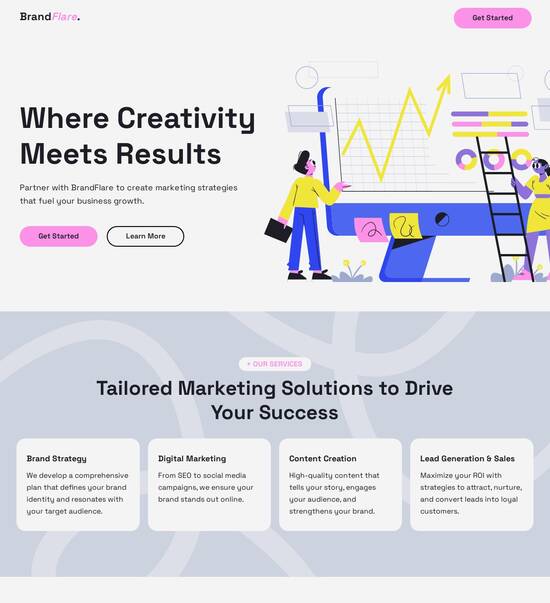
Front page template optimized for Unix
Explore Similar TemplatesAbout template
Customize your Unix-optimized front page template for a flawless user experience. Get started now!
Recommended templates

Easy to build without coding
With the intuitive drag-and-drop builder, anyone on your team can create high-converting pages without any knowledge of code or design. Make enhancements to your landing page with custom widgets using Javascript, HTML/CSS, or third-party scripts.

Multiple layouts for any industry and goal
Select from 500+ landing page layouts built to boost conversions across industry-specific scenarios. Customize them by adjusting fonts, adding images, and generating on-brand content with the AI assistant. Quickly scale with Instablocks® and Global Blocks that you can save, reuse, and update globally.

Loads fast and looks polished on any device
Every template is responsive, which means they present professionally on any device and load blazingly fast with our Thor Render Engine. You can also power them up with Google AMP technology to deliver an unparalleled mobile experience and drive higher conversions.

Robust analytics & experimentation
Get real-time updates and reporting across all your devices, showing the number of visitors, conversions, cost-per-visitor, and cost-per-lead. Launch AI-powered experiments, run A/B tests, and use heatmaps to analyze user behavior, then optimize your landing page to maximize conversions.







Easy to build without coding
With the intuitive drag-and-drop builder, anyone on your team can create high-converting pages without any knowledge of code or design. Make enhancements to your landing page with custom widgets using Javascript, HTML/CSS, or third-party scripts.
Multiple layouts for any industry and goal
Select from 500+ landing page layouts built to boost conversions across industry-specific scenarios. Customize them by adjusting fonts, adding images, and generating on-brand content with the AI assistant. Quickly scale with Instablocks® and Global Blocks that you can save, reuse, and update globally.
Loads fast and looks polished on any device
Every template is responsive, which means they present professionally on any device and load blazingly fast with our Thor Render Engine.
Robust analytics & experimentation
Get real-time updates and reporting across all your devices, showing the number of visitors, conversions, cost-per-visitor, and cost-per-lead. Launch AI-powered experiments, run A/B tests, and use heatmaps to analyze user behavior, then optimize your landing page to maximize conversions.
All the features you need to build lead-generating landing pages
Explore more featuresLearn how to build top-performing landing pages for any goal
FAQs
Leading the way in building high-performing landing pages





A comprehensive guide to using Instapage for powerful landing page optimization
Instapage is known for its robust landing page and conversion rate optimization (CRO) capabilities that help marketers in the USA maximize the impact of their digital campaigns. This guide will outline the essential steps to effectively utilize Instapage's various features to boost your marketing results. Whether you are in business services, tech/SaaS, or any other sector, instapage enables you to quickly create pages tailored to your target audience.
Understanding Instapage's core features
Before creating landing pages, it’s crucial to grasp the unique features that Instapage offers. This platform is designed to facilitate fast deployment, user-friendly design, and thorough optimization of landing pages. Here are some of the standout components you can leverage:
- 100+ customizable templates: Access a variety of layouts that cater to different marketing campaigns, allowing you to quickly adapt and launch your pages.
- Built-in A/B testing: Instapage enables you to test multiple variations of your pages, ensuring that you can make data-driven decisions for maximizing conversions.
- Advanced analytics dashboard: Track user behavior and performance metrics, which helps you understand the effectiveness of your landing pages.
Creating your landing page
The first step in using Instapage is creating your landing page. This is a straightforward process due to its intuitive drag-and-drop builder, which allows you to design a visually appealing page without any coding knowledge:
- Select a template that aligns with your campaign objectives. Each template is designed with conversion best practices in mind.
- Customize your page by adding images, text, and lead generation elements that resonate with your audience.
- Preview your changes in real-time to ensure everything appears as intended before publishing.
Optimization for higher conversions
Once your landing page is live, the next crucial phase is optimization. Utilizing Instapage's built-in tools helps you refine your page for better performance:
- Implement dynamic text replacement to tailor your messaging according to the campaigns driving traffic to your landing page.
- Utilize heatmaps to analyze user interactions and make informed adjustments to page layout and design.
- Conduct A/B tests by changing headlines, images, or CTAs to determine which elements yield the best results.
Conclusively, Instapage streamlines the entire process of landing page creation and optimization, positioning marketers for success.
Use Instapage today to revolutionize your marketing campaigns and witness measurable improvements in your conversion rates. Ready to start? Dive into creating engaging landing pages that showcase your brand effectively!
Front page template optimized for Unix
Understanding front page templates in the Unix context: A paradigm shift
Front page templates in the Unix environment are an essential aspect of modern web development. They enable developers to create and manage web pages efficiently. In the Unix context, these templates serve as a guiding framework that maintains consistency and functionality across various projects. By leveraging Unix’s inherent file system hierarchy and command-line prowess, developers can streamline their workflow and enhance productivity.
Unix has been a foundational technology for web servers, offering robustness and reliability. Its architecture allows for multiple processes to run simultaneously, making it ideal for hosting websites that require efficient resource management. The synergy between front page templates and Unix systems empowers developers to build dynamic, responsive websites that meet modern user expectations.
Historical evolution of front page templates
The journey of web design tools has been marked by significant advancements. Initially, web design was a manual process involving coding each page individually. However, as the web evolved, so did development practices. Early tools focused on basic templates, which quickly became insufficient as user needs grew. Unix began to play a crucial role in this shift by providing automation and scripting capabilities, allowing for the widespread adoption of templates.
Key milestones in Unix template development include the introduction of command-line tools that facilitated template creation and management. As frameworks like CGI and Perl emerged, developers were able to utilize Unix resources to create more sophisticated web applications. This evolution has led to today's robust, customizable front page templates that harness the power of Unix environments.
Core features of front page templates optimized for Unix
One of the defining features of front page templates optimized for Unix is their flexible file structure. Unix's directory and file management capabilities allow for organized storage of templates, scripts, and assets. This allows developers to structure their projects intuitively and manage files efficiently. Moreover, the distinction between dynamic and static page generation becomes pivotal. Dynamic pages offer real-time data and user interaction, while static pages provide faster loading times for content that doesn't change often.
Customization is another core aspect of these templates. Developers can efficiently utilize shell scripts to automate updates and modifications across multiple templates. The command-line tools available in Unix systems offer powerful options for editing and managing template files, providing flexibility in design and functionality. This fosters a culture of rapid iteration and improvement, aligning with agile development methodologies.
Cross-platform compatibility is indispensable in today's interconnected world. Unix-based systems can integrate seamlessly with various operating systems, enhancing cooperative efforts in diverse development environments. This cross-functionality allows teams to collaborate effectively, ensuring that templates can be shared and utilized across different platforms.
Benefits of using Unix-optimized front page templates
Utilizing front page templates designed for Unix brings numerous benefits, particularly in terms of performance and speed. Unix servers are designed for high performance and efficiency, leading to streamlined server responses. Cache management is simplified by using templates that efficiently leverage Unix's capabilities. When templates are optimized for Unix, overall resource consumption is minimized, resulting in faster load times and improved user experiences.
Enhanced security features are also a significant advantage. Unix has built-in security protocols that protect against common web vulnerabilities. By following best practices in front-end template security, developers can safeguard their sites against potential threats. This includes utilizing robust user authentication processes and keeping templates updated to protect against exploits.
Lastly, scalability is a crucial factor for growing projects. When a website experiences increased traffic, a Unix-optimized template can adapt without compromising performance. Applying best practices enables teams to maintain efficiency while accommodating larger user loads. This adaptability is vital in today's fast-paced digital landscape, ensuring websites remain reliable and functional as their user base expands.
Innovative technologies behind Unix-optimized templates
To enhance the functionality and usability of front page templates, several innovative technologies have been integrated into Unix workflows. Popular frameworks like Django, Ruby on Rails, and Flask offer powerful tools for template management and rendering. Developers can leverage these frameworks' unique features to build dynamic and responsive web applications, maximizing the benefits of their Unix systems.
The utilization of containerization technologies such as Docker and Kubernetes has revolutionized the deployment process. Containerized environments allow developers to create, manage, and deploy applications efficiently, ensuring consistency across different deployment stages. This containment isolates the development process from the live environment, reducing the likelihood of conflicts and improving overall deployment reliability.
Incorporating continuous integration and continuous deployment (CI/CD) practices further enhances the development cycle. Automating updates and maintenance through CI/CD pipelines streamlines workflow and improves product reliability. With these practices, developers can efficiently push updates to templates without disrupting user experience.
Engaging with the Unix community: Collaboration and support
Engagement with the Unix community is essential for developers looking to optimize their front page templates. The collective knowledge shared in Unix forums has become a vital resource for troubleshooting and guidance. Platforms like Stack Overflow, Unix & Linux Stack Exchange, and various dedicated mailing lists offer spaces for developers to connect, share solutions, and seek help for template-related challenges.
Creating a personal network of Unix developers enhances collaboration even further. Strategies such as attending meetups, participating in open-source projects, and engaging through social media can help build a supportive development environment. Networking in these spaces can lead to collaborative projects and continuous skill enhancement as team members share insights and experiences.
Navigating common questions about front page templates in Unix
As developers explore the potential of front page templates in the Unix environment, several common questions arise. One frequent inquiry concerns the key advantages of utilizing Unix for template development. The robust performance, security features, and scalability that Unix systems provide are often highlighted as primary benefits. Understanding these aspects can guide developers in their approach and implementation of templates.
Another common question involves ensuring template security within Unix systems. Security best practices such as using secure coding standards, applying patches, and employing firewall configurations play a pivotal role in safeguarding web applications. Providing clarity on these methodologies helps alleviate concerns and builds confidence in using Unix for template design.
When it comes to template customization, developers often seek guidance on various methodologies for modifications. Exploring the flexibility of different scripting languages and tools available in Unix can assist developers in efficiently implementing changes. They may also face challenges when integrating with content management systems; addressing these issues requires thorough testing and understanding of both systems.
Real-world applications and case studies
To understand the practical value of Unix-optimized front page templates, examining real-world applications can be enlightening. For instance, consider a tech startup that capitalized on Unix templates for a rapid development cycle. By leveraging the framework’s flexibility, they implemented user feedback quickly, resulting in a streamlined product development process and ultimately a successful product launch.
In contrast, a nonprofit organization overhauled its website using Unix templates to improve user engagement. The organization adopted a responsive design that accommodated diverse user needs, which was bolstered by efficient scalability practices. Their success highlighted not only the importance of front page templates but also the value of community feedback and support in achieving design objectives.
The role of access and previews in template development
Access to preview mechanisms plays a crucial role in effective web design. Developers can use various tools for live previews in Unix environments, such as browser-sync and Grunt. These tools allow teams to view changes in real-time, facilitating more seamless design iterations and reducing miscommunication during the development process.
Ensuring that templates meet accessibility standards is equally essential. Strategies for creating accessible front-end templates include implementing ARIA (Accessible Rich Internet Applications) roles and attributes and following the Web Content Accessibility Guidelines (WCAG). Resources for testing compliance with these standards can improve usability and expand the audience reach, resulting in a more inclusive web experience.
Future trends in front page template development for Unix
Looking ahead, several trends are expected to shape the future of front page template development within Unix systems. Among these, the evolution of design technologies will play a significant role. Emerging trends such as serverless architecture and AI-driven content generation are altering how developers create and manage templates. Keeping an eye on these trends can inform future development strategies.
Additionally, the increasing importance of user-centric design requires developers to focus on maximizing user experiences. Building templates around user feedback and preferences encourages greater engagement and conversion rates. Collaborating with multidisciplinary teams allows developers to gather diverse insights, ultimately refining the functionality and appeal of front page templates.
Strategies for mastering front page templates in Unix
To effectively master front page templates in the Unix context, development teams could adopt several best practices. Implementing agile methodologies can improve responsiveness to change and user feedback, ensuring that the project remains aligned with user needs. Establishing coding standards and best practices within teams enhances code readability, maintainability, and quality across projects.
Continuous learning and improvement must also be a priority in mastering these templates. Recommended tools such as version control systems, integrated development environments, and online education platforms can facilitate ongoing skill enhancement. Building a personal growth plan centered around front page templates and Unix technologies ensures developers stay updated on trends and best practices, positioning themselves for success.
Ready to skyrocket conversions?
Supercharge your ad campaigns with high-performing landing pages
Get started














